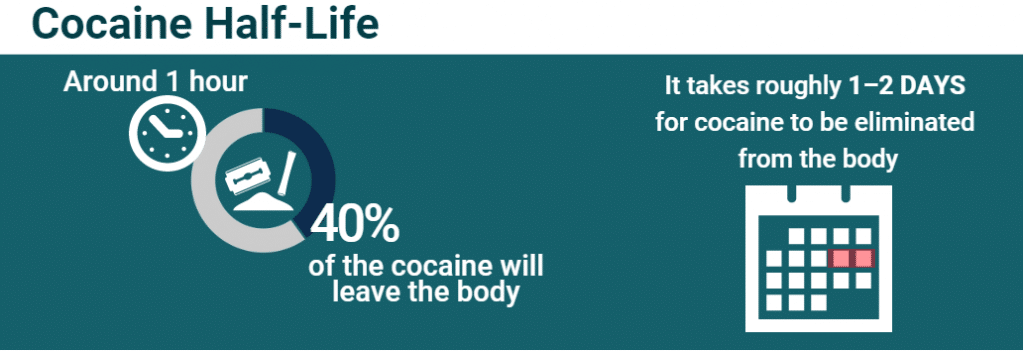How long cocaine stays in your system depends on what is being tested and other biological factors. Knowing these time frames can help with drug tests and withdrawal.
As a general guide:
- Most people feel the effects of cocaine immediately after use.
- If someone has used cocaine only once, it’s usuallydetectable in urinefor around three to five days.
- Someone who takes a larger dose of cocaine or uses it occasionally may show up in urine for three to seven days.
- For frequent or heavycocaine users, a urine test can show the drug for 5–14 days after the last dose.
How Long Does Cocaine Last?
Cocaine is a fast-acting stimulant with a quick high that lasts for only a short period. Generally, a cocaine high lasts for5–30 minutesdepending on whether it was snorted, smoked, or injected. Snorting cocaine is most common and usually the slowest method of ingestion. Smoking or injecting it will provide a high in as quickly as five minutes.
Cocaine is a stimulant that makes a person feel euphoric and gives them energy. Because it’s so short-acting, people will often use it over and over in a short period. It is common for people to “binge” cocaine over several hours to extend the high.
How Long Does Cocaine Stay in Your System?
Some of the specific factors that determine how long cocaine stays in the system of a user include the amount they use, whether they mixed it with other substances, how often they use cocaine, the method of administration, how healthy they are, and the method of drug testing they’re undergoing.
For a long-term or heavy user of cocaine, the drug can stay in their system and be detectable on a cocaine test for longer. In certain types of drug screens,most notably hair follicle sampling, cocaine can show up in the results for up to three months after someone uses it. Additionally, people who have impaired kidney and liver function may find that cocaine stays in the system for longer because it is removed more slowly.
How Long Does Cocaine Stay in Urine?
When someone has a urine test done, the test is not looking for the cocaine molecule because it leaves the body too quickly. It is looking for benzoylecgonine (BE) which lasts for much longer in the system. In some studies, BE is detectable for up to106 hours or 4.5 days after the last ingestion of cocaine. Most commercial urine cocaine tests have a detection window of 3–5 days.
How Long Does Cocaine Stay in Your Blood?
Cocaine is quickly metabolized from the blood, so this type of test is not used for drug testing. The half-life of cocaine is about1.5 hours. Most drugs are undetectable in the blood afterfive half-liveshave passed, approximately 7.5 hours for cocaine.
How Long Does Cocaine Stay in Saliva?
Some manufacturers claim that their saliva tests for cocaine can detect cocaine use from1–3 daysafter the last usage. Generally, saliva tests are less invasive than other testing but they can be more expensive so they usually aren’t as common.
How Long Does Cocaine Stay in Your Hair?
All hair testing can detect substances for the same length of time, about90 days. The reason is that the testing window is based on how quickly the hair usually grows. Substances are deposited in the hair after use and can be detected for up to three months. This type of testing is expensive and hard to perform, so it is less common.
How Long Does Cocaine Stay in Breastmilk?
Cocaine can stay in the breast milk for up to36 hoursafter the most recent use. Even small amounts of cocaine exposure in an infant can be extremely harmful, with symptoms including irritability, dilated pupils, tremor, hyperactive reflexes, excessive crying, mood swings, high blood pressure, and seizures. Cocaine should never be used by breastfeeding mothers.
Cocaine Half-Life
Cocaine can stay in your system for about 7.5 hours after you take it but cocaine also has an active metabolite called benzoylecgonine, and that takes longer to be expelled from the body completely. It’s usually between one and two days before this metabolite leaves the system.

Estimates show that when someone takes cocaine,about 40% hydrolyzesto form benzoylecgonine. Then, it is metabolized by the liver, producing ecgonine methyl ester. Cocaine has a relatively short half-life of around 1.5 hours, while benzoylecgonine has a half-life of5.5–7.5 hours.
This longer half-life is why benzoylecgonine is the target of drug testing rather than cocaine. Since it takes about five half-lives for a drug to leave the body, benzoylecgonine is present in the body for 27.5–37.5 hours.
Factors That Impact How Long Cocaine Stays in the System
Cocaine is a fast-acting drugthat usually leaves the body quickly. Even if it’s present in the body for several hours, the high will only last5–30 minutesafter the last dosage because the body adjusts very quickly to the changes that cocaine causes.
Once ingested, cocaine tells the brain and spinal cord neurons to release extra dopamine. High levels of dopamine are what give cocaine its addictive potential. However, the body is extremely efficient at correcting the excessively high dopamine. The effects are reversed in only a few hours, but cocaine and its metabolites may stay detectable in the body for several days.
Dosage
Dosage is a significant factor. The larger the dose, the longer it will take for the drug to be fully eliminated from your system. When a person takes a higher dosage of cocaine or uses it repeatedly for a longer period, it takes longer for the body to remove it.
The purity of the drug must also be considered. The purer the cocaine, the more potent its effects and the longer it will stay in the system.
History of Use
Cocaine stays in the body longer in people who use it long-term.Detoxifying can take significantly longerthan it would for those who use it short term, and the substance may show up in drug tests for a longer period. Part of the reason for this is a longer history of use means a person has a higher tolerance and may take higher doses.
Frequency of Use
The more often you use cocaine, the harder it is for your body to eliminate it. Your body’s elimination systems lose functionality and efficiency with frequent use.
Other Substances Used
For a person who uses additional substances in addition to cocaine, the danger can be significantly greater—for example, taking cocaine while drinking alcohol producescocaethylenein the body, a substance that is significantly more dangerous than either substance by itself. It stays in the body longer than cocaine and has a higher risk for seizure, liver damage, compromised immune system and immediate death.

How Is Cocaine Taken?
The method of ingestion is another important factor in how long it will take for cocaine to leave your system.
If youinject cocaine, you may get a very fast high that lasts for a shorter period of time, because the substance will peak faster and leave the body faster. When someone injects cocaine, the peak concentration in the body occurs within5–10 minutes.
For people whosnort cocaine, a high may last from up to15–30 minutes. If you smokefreebase cocaine, the half-life may be different.
It’s important to remember that even after cocaine is eliminated, the body produces active metabolites from the cocaine that can still create effects and be detected for a long period after use.
What to Expect During a Cocaine Drug Test
A cocaine drug test (often called a drug screen) can detect the drug by using urine, blood, hair or saliva.
It will show whether or not cocaine or its metabolites are present in the system. Metabolites are chemicals produced by the body as a byproduct of removing cocaine. The two metabolites that can show up in a cocaine drug test include benzoylecgonine and ecgonine methyl ester. A drug test for cocaine use is includedas part of a wider drug screeningthat also looks for opioids, marijuana, amphetamines, and PCP.
Drug tests can be done in a doctor’s office or clinical setting, and the results can be shown in just a few minutes when a rapid screening is done. The most common ways for a cocaine drug test to be conducted include urinating in a cup or giving a saliva sample from the mouth. While urine and saliva tests are more popular ways of doing a drug test for cocaine, hair can be used as well. It can detect the use of cocaine for months after the person has actually done the drug, but it’s not always an accurate process.
If you or a loved one are struggling with cocaine abuse and addiction, help is available. The Recovery Village offers compassionate, evidence-based treatment with professional addiction specialists. Contact us today to discuss cocaine addiction treatment programs that can meet your needs.

















